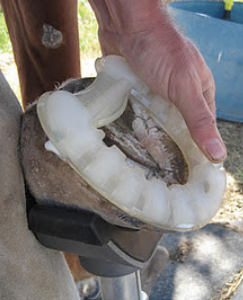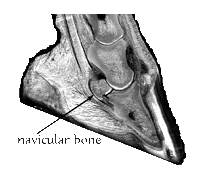The horse’s foot is completely surrounded by a substance similar to your fingernail to protect it against having to sustain the wear and tear of having to carry one quarter of your horse’s weight over the varying terrain you may be riding him over. A horse’s foot consists of an outer layer of horn (hoof), inside which is contained the pedal and navicular bones, and the deep digital flexor tendon which is attached to the pedal bone.
The foot also contains the digital pad, lateral cartilages, coronopedal joint, blood vessels, and nerves. The foot as a whole absorbs concussion and by its continuous growth, it is able to replace its striking surface which is lost through everyday wear and tear. As a horse owner, you can help assist your horse in this latter process by choosing the right farrier for your particular horse’s needs. Farriery is one of the most vital of all the professions connected to the horse. If there were no farriers, the entire horse world would just about come to a stop; except for a few fortunate individuals lucky enough to be able to ride always and exclusively on grass, or in an arena completely void of rocks.
Even these folks would find it difficult to keep their mounts sound and true if there were no one to trim, shape, and generally care for their pony’s feet. The best way that I have found to increase my own knowledge of my horse’s feet is to watch my farrier shoe my horses. It will also be to your advantage to pay attention, and actively participate when your farrier comes out. Here are a few things that I always try to do to help out to make the whole process easier. I always let my farrier know in advance if I am going to have any
special shoeing needs, or if I have a youngster that is going to be shod for the first time. Horses being shod for the first time should be used to having their feet picked out and be familiar with having the wall and sole of their foot tapped. You should ALWAYS present your horses for shoeing with clean, dry feet and legs. And always provide the farrier with a well lit area, and dry solid footing; undercover if possible. The first time the farrier shoes your horse, let him know how your horse is going and what discipline you use him for: trail, cutting, endurance etc. Assuming the horse is already shod, he will look at the wear of the shoes and the growth of the hoof to determine wear and growth patterns. With your help, the farrier will then determine whether your horse has any problems such as overreaching, stumbling, dragging its toes etc. If such problems are discovered, your farrier will discuss alternative shoeing solutions with you. The above ideas will help you and your farrier develop a relationship that will benefit you both, and more importantly, benefit your horse.
 Dear HOOF-it Technologies:
My mare was diagnosed with “Navicular Syndrome”. One day I noticed that her stride had become short and stabby like. We took her to the vet for a full examination and x-rays and sure enough she was diagnosed with “Navicular Syndrome”. The vet prescribed meds (isoxsuprine) that were given to her religiously but she still seemed too uncomfortable to go back to her regular workouts. After looking on the internet I found your HOOF-it plastic horseshoes and was eager to try them. I bought a pair and gave them to my farrier to put on. My farrier is a bit of a traditionalist and gave me a cross eyed look but after some convincing he went ahead and put them on. Much to our amazement she walked out of the cross ties a different horse. We put her on a line and her movement was night and day. Her short and stabby stride became once again free and long. She has now been able to go back to regular work and has even been shown in the childrens hunters. I know she will never go back to the 3’6 ring but she is comfortable and happy. Who could ask for anything more? Thank you for making a horseshoe that just makes sense!
Sincerely,
Ann Alexander
Dear HOOF-it Technologies:
My mare was diagnosed with “Navicular Syndrome”. One day I noticed that her stride had become short and stabby like. We took her to the vet for a full examination and x-rays and sure enough she was diagnosed with “Navicular Syndrome”. The vet prescribed meds (isoxsuprine) that were given to her religiously but she still seemed too uncomfortable to go back to her regular workouts. After looking on the internet I found your HOOF-it plastic horseshoes and was eager to try them. I bought a pair and gave them to my farrier to put on. My farrier is a bit of a traditionalist and gave me a cross eyed look but after some convincing he went ahead and put them on. Much to our amazement she walked out of the cross ties a different horse. We put her on a line and her movement was night and day. Her short and stabby stride became once again free and long. She has now been able to go back to regular work and has even been shown in the childrens hunters. I know she will never go back to the 3’6 ring but she is comfortable and happy. Who could ask for anything more? Thank you for making a horseshoe that just makes sense!
Sincerely,
Ann Alexander


